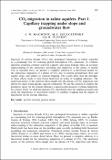CO2 migration in saline aquifers. Part 1. Capillary trapping under slope and groundwater flow
Author(s)
MacMinn, Christopher W.; Szulczewski, Michael Lawrence; Juanes, Ruben
DownloadJuanes_CO2 Migration.pdf (1.133Mb)
PUBLISHER_POLICY
Publisher Policy
Article is made available in accordance with the publisher's policy and may be subject to US copyright law. Please refer to the publisher's site for terms of use.
Terms of use
Metadata
Show full item recordAbstract
Injection of carbon dioxide (CO2) into geological formations is widely regarded as a promising tool for reducing global atmospheric CO2 emissions. To evaluate injection scenarios, estimate reservoir capacity and assess leakage risks, an accurate understanding of the subsurface spreading and migration of the plume of mobile CO2 is essential. Here, we present a complete solution to a theoretical model for the subsurface migration of a plume of CO2 due to natural groundwater flow and aquifer slope, and subject to residual trapping. The results show that the interplay of these effects leads to non-trivial behaviour in terms of trapping efficiency. The analytical nature of the solution offers insight into the physics of CO2 migration, and allows for rapid, basin-specific capacity estimation. We use the solution to explore the parameter space via the storage efficiency, a macroscopic measure of plume migration. In a future study, we shall incorporate CO2 dissolution into the migration model and study the importance of dissolution relative to capillary trapping and the impact of dissolution on the storage efficiency.
Date issued
2010-11Department
Massachusetts Institute of Technology. Department of Civil and Environmental Engineering; Massachusetts Institute of Technology. Department of Mechanical EngineeringJournal
Journal of Fluid Mechanics
Publisher
Cambridge University Press
Citation
Macminn, C. W., M. L. Szulczewski, and R. Juanes. “CO2 migration in saline aquifers. Part 1. Capillary trapping under slope and groundwater flow.” Journal of Fluid Mechanics 662 (2010): 329-351. © Cambridge University Press 2010.
Version: Final published version
ISSN
0022-1120
1469-7645